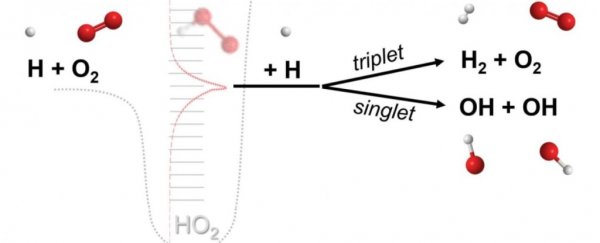Scientists have unearthed a new class of chemical reaction which had been overlooked since it was first predicted to exist almost 100 years ago.
It is thought this could open the possibility for new engine designs and even be used to understand a range of fundamental issues around climate change and the conditions that gave rise to life itself.
In 1956, Cyril Hinshelwood and Nikolay Semenov were awarded the Nobel Prize in chemistry for their work hypothesising the existence of a fourth type of chemical reaction.
But for decades afterward researchers concluded these reactions weren't particularly important, so no one ever really studied the idea closely, until now.
Previously, only three classes of reactions have been seen as chemically important:
- Unimolecular reactions, where one reactant makes or breaks bonds.
- Bimolecular reactions, where two reactants collide and react.
- Termolecular association reactions, where two reactants collide and combine, and then bump into a third molecule that steals some energy to make it stable.
The new and fourth type of three molecule reaction is very similar to the termolecular association reactions (the third type in the list) but instead of removing energy, the third molecule takes part in the making and breaking of chemical bonds.
"Combustion has always been a launching point for understanding all sorts of other chemical mechanisms," says lead researcher Michael Burke, from Columbia University. "Potentially there could be innumerable reactions from this new class that impact how we model gas phase chemistry."
"From designing new types of engines to understanding the planetary chemistry responsible for cloud formations, climate change, evolution of pollutants, even perhaps the sequence of reactions that could impact the conditions for extra-terrestrial life. Our discovery opens up a whole new world of possibilities."
Finding the new reaction took far more than your standard experimental chemistry kit.
Researchers used high powered computational methods that mixed quantum chemical computations with kinetic transport computations to simulate the reaction and movements of gas molecules simultaneously.
"The power of these state-of-the-art computational methods is that they can provide a unique lens into harsh chemical environments ill-suited for experimental techniques for studying individual reaction dynamics," says Burke.
"Our calculations are based on computational data produced from first principles: the Schrödinger equation, the fundamental equation of quantum mechanics.
"Combining these data with other physics-based models enables us to directly pinpoint the impact of just a single reaction out of many, in a way that is very difficult to do in the lab."
This is where fundamental research starts to solve some real life technological problems.
Space vehicles experience very high temperatures in their descent back to Earth. Burke speculates that this fourth class of reactions could impact the heat transfer to the vehicle, with significant knock-on effects for the design of thermal protection systems to keep astronauts and payloads safe when returning to Earth.
"It has long been known that many gas phase association reactions have very low effective rates, because the initial [molecule that is formed] does not live long enough… and just falls apart…" says William H. Green, a scientist not involved with the study, from MIT.
The next stage of the research is to use what they have learnt from the three-molecule reaction to form general theories to help explain important unanswered questions in planetary science and combustion environments.
The study was published in Nature Chemistry.
